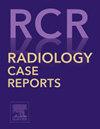一例枪伤后股深动脉假性动脉瘤的线圈栓塞治疗:病例报告和文献综述
Q4 Medicine
引用次数: 0
摘要
在这个病例中,患者的大腿受到枪伤,并接受了粉碎性骨折的手术治疗。出院六周后,患者出现大腿上部疼痛。多普勒超声显示股深动脉假性动脉瘤,计算机断层扫描(CT)证实了这一点。我们使用线圈栓塞术(近年来全球新采用的一种方法)来闭塞假性动脉瘤。这反映了导致此类罕见病例的复杂、未知机制,并引起人们对需要进行更广泛研究以了解潜在病理过程的病例的关注,从而更好地进行管理和改善预后。此外,本病例还包括数字和图像,说明了干预前后的发现,大大增强了手术的视觉吸引力。此外,它还全面回顾了其他相关病例,每个病例都有详细的介绍。最后,本病例揭示了栓塞技术在发展中国家的创新应用,与其他技术相比,该技术挽救了生命,提高了成本效益,减少了并发症。本文章由计算机程序翻译,如有差异,请以英文原文为准。
A case of postgunshot deep femoral artery pseudo-aneurysm managed with coil embolization: A case report and literature review
In this case, the patient sustained a gunshot injury to the thigh and underwent surgery to treat a comminuted fracture. Six weeks after discharge, the patient presented with upper-thigh pain. Doppler ultrasound showed a deep femoral artery pseudoaneurysm, confirmed with computerized tomography (CT). We used coil embolization, a newly used method worldwide in recent years, to occlude the pseudoaneurysm. This reflects the complex, unknown mechanisms that contribute to such rare findings and draws attention to cases that require more extensive studies to understand potential pathological processes, leading to better management and improved outcomes. Furthermore, this case includes figures and images that illustrate the findings both pre- and postintervention, significantly enhancing the visual appeal of the procedure. Additionally, it provides a comprehensive review of other related cases, each with detailed presentations. Finally, this case illuminates the innovative application of embolization techniques in developing nations, which has resulted in lifesaving, cost-effectiveness, and a reduction in complications compared to other techniques.
求助全文
通过发布文献求助,成功后即可免费获取论文全文。
去求助
来源期刊

Radiology Case Reports
Medicine-Radiology, Nuclear Medicine and Imaging
CiteScore
1.10
自引率
0.00%
发文量
1074
审稿时长
30 days
期刊介绍:
The content of this journal is exclusively case reports that feature diagnostic imaging. Categories in which case reports can be placed include the musculoskeletal system, spine, central nervous system, head and neck, cardiovascular, chest, gastrointestinal, genitourinary, multisystem, pediatric, emergency, women''s imaging, oncologic, normal variants, medical devices, foreign bodies, interventional radiology, nuclear medicine, molecular imaging, ultrasonography, imaging artifacts, forensic, anthropological, and medical-legal. Articles must be well-documented and include a review of the appropriate literature.
 求助内容:
求助内容: 应助结果提醒方式:
应助结果提醒方式:


